A mystery and some fishy business in Agadir
Mike and Jo discover some interesting local history in Agadir.27 to 31 Dec 07
First a mystery.
The ride to Agadir down the coast road is a delight as it winds through the foothills of the High Atlas where they sweep down to the sea. The surface is no worse than that on many of our SE Queensland roads and the scenery is excellent.
At first sight Agadir surprised us. It has wide boulevards, modern buildings and a broad strip of modern resort hotels clustered along the waterfront. What it lacks, however, is an old quarter reflecting the citys foundations as a Portuguese trading post in the 16th Century.

Modern Agadir. Just dont ask about what happened.
When we asked about this we were told that the city had been destroyed by an earthquake in 1960 and had to be rebuilt. This story interested us, so we set out to find out about the 1960 catastrophe.
Our first stop was the site of the old Berber Kasbah located on a hill overlooking the town. We found an area that had been bulldozed clean leaving only a few old walls. There was not much else and the story about what happened was not to be found there.

The view from the old Kasbah was fantastic, but the area had been bulldozed flat and there was no useful information available.
We found the site of the pre-1960 Medina. Once again this had been bulldozed flat and apart from a few low walls and the site of some mass graves, there was no story here. Our next stop was the Earthquake Museum, surely here we would find the story!

The saving grace of the Museum was the beautiful roses at the entrance.
Its that kind of logic that continually gets us into trouble. Inside the museum there were a few before and after photos but nothing to tell us anything about the earthquake. Our interrogation of locals garnered a few basic facts and one chap showed us some old postcards from pre-earthquake time.
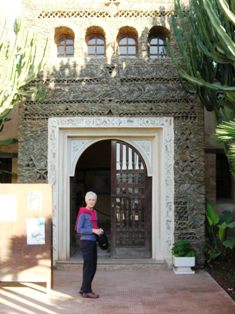

Apart from a few photos, the museum provided only hints about the drama that unfolded in Agadir.
At the end of two days of investigation we knew that there had been an earthquake in 1960, about 12,000 or 15,000 souls perished and the city had been rebuilt leaving the site of the original kasbah and medina bare. It was clear to us that there wasnt much more information available.

The modern city shows little sign of a past earlier than 1960.
At one level this was disturbing. This was, after all, the history of modern Morocco estranged from modern Moroccans. At another level, we understood that in a developing country like Morocco, there are simply many other more important priorities than the documenting of earthquakes for esoteric tourists.
Then, on our fourth day in Agadir we came across an interesting man. Bernd Laube is a German, a Professor of Mathematics and Science, a Moroccan enthusiast who has visited this country more than 35 times, and the author of the only book (still unpublished) on the 1960 earthquake. Information was so hard to get that it had taken Bernd nine years to assemble the story of the Agadir catastrophe. He had clearly not been deterred by the lack of an official Moroccan record of the event.

Bernd with the draft of his book. Finally we found our story.
The story we learnt from Bernd was amazing. The earthquake, as earthquakes are, was caused by the movement of the tectonic plates (hands up all those who knew that Morocco was once connected to Pennsylvania). It happened at Agadir because the town sits at the foot of the High Atlas on about 1000m of unstable sedimentary deposits. The town still sits astride a fault line.
The earthquake (measuring 7 on the old Richter Scale) happened at 0043hr on 29 February 1960. The tremor took only 15 seconds, but in this time the buildings of the old and new towns simply fell down on their occupants. 15,000 people died in seconds and another 12,000 became casualties. Among the old buildings of the Kasbah all but one thousand of the inhabitants perished in the initial seconds.
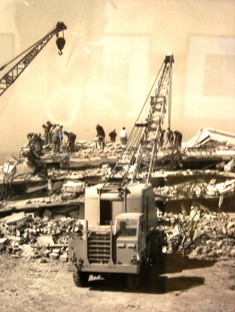
This photo shows the way the original buildings collapsed. It all happened in 15 seconds and many did not have a chance.
Those that survived moved off the mountain and established a shanty town on the low land taking with them the memory of that disastrous night. Later, the authorities dispersed the shanty town dwellers because they had no title to the land they occupied and dispersed with them the collective memory of the earthquake.

This dramatic set of photos shows the Hotel Saada before and after. The reason for the high death toll is obvious.
International aid was sent by the US (US Army engineering plant in particular), the French, Spanish and other European nations. A massive evacuation of 35,000 survivors further dispersed the memory of the night.

A few buildings did survive the earthquake. This is the old cinema, still in use today.
Most of the inhabitants were Berbers who are traditionally loath to work for wages and tend to mercantile and trade for their living. By the time the city was inhabitable, many of these folk were established elsewhere and did not return and the memory was further diluted. Almost everyone who lives in Agadir today has arrived since the earthquake.
The rebuilding of Agadir was spectacular. We heard some stories that donor countries had been responsible for separate areas but this turned out not to be the case (despite the ornate Italian ceilings in the restaurants in one area). The money went to a central fund and contracts were let from that. A new building code was introduced for the reconstruction.
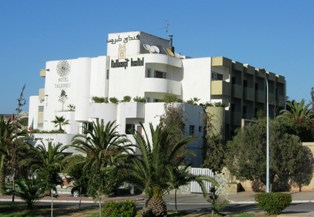
New Agadir.
Interestingly, the architectural style chosen was Bauhaus or Post Modern because they best reflected the traditional style of housing and the three story limit imposed by the reconstruction authority. The city has many streets with beautifully integrated Post Modern buildings. A coat of paint and even some of the poorer areas would look a treat.

A Bauhaus street not far from our hotel.
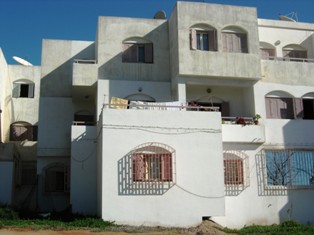
Typical new town construction.

Downtown apartment is still stylish today.

The small market near our hotel is built to modern reinforced concrete standards and will certainly survive better than traditional structures.
More than 44,000 new trees were planted. Many of them were Australian eucalypts which, 40 years on, provide some lovely shaded areas.
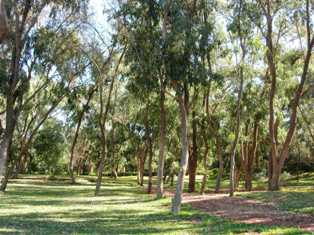
Good old gum trees everywhere!
And so the mystery was not so mysterious at all. It had all been over in seconds. Many that survived were dispersed and didnt return and those who came after were newcomers with little interest in the past. After all, there was nothing to show for it. Everything had been bulldozed flat.

Not everything in new Agadir is stylish.
And now a small fish story
While standing on the wall of the old Agadir Kasbah pondering what had happened to the people who lived there for 500 years then didnt, we were looking straight down on the port. We were amazed by the size of the trawler fleet docked there. Several hundred large trawlers were tied up in matching sets at company docks. There were also hundreds of intermediate trawlers crowded into another area and the small open coastal dinghies were crowded into several other areas.

One small part of the sardine fleet as seen from the old Kasbah.
Being both idle and curious, there was nothing else for it but to clamber onto the Elephant, convince the port security that we had bone fide business and go and have a look for ourselves. What we found in Agadir was the worlds biggest sardine fishing fleet and a mad scramble of activity. Purposeful crushes of people unloading catches, loading ice and vittles, and boxes of sardines everywhere.

Unloading the small boats by hand looked like hard work.

Boxes of sardines everywhere.
After wandering around and taking an interest in the sardine business for a while, there really was nothing else for it but to find a dockside restaurant and order up a plate of fresh grilled sardines and a beer for lunch. It seemed like a good thing to do.
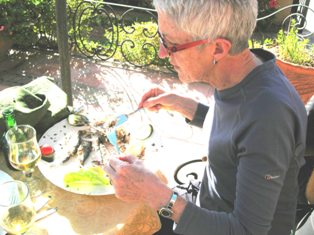
Jo finds the small bones.
We finished our time at Agadir with a New Years Eve dinner and a bottle of Moroccan wine followed by a walk along the crowded waterfront for a coconut ice cream. It was 34 years since the New Years Eve we had met in Sydney and I had given Jo her first pillion on a bike. A lot had changed in the intervening years, but then, not so much as you might think.

Tapping away!
